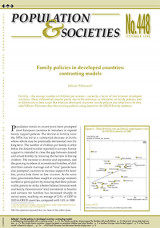
@@src2@@
Family policies in developed countries: contrasting models
Population and Societies
n° 448, September 2008
Fertility - the average number of children per woman - varies by a factor of two between developed countries. These differentials may be partly due to the existence, or otherwise, of family policies, and to differences in their scope. But what are developed countries’ family policies and what forms do they take? Olivier Thévenon describes existing policies using data from the OECD Family database.
Most developed countries are introducing a system of support for families or expanding their existing one. Investment by OECD countries in family support rose from 1.6% of GDP on average in 1980 to 2.4% in 2003. One of the aims of family policies is to increase fertility while raising wom-en’s workforce participation. The amount invested and the forms of family support vary considerably between countries. The main differences concern parental leave and childcare services for working parents of children aged under three. The northern European countries are the most generous, both in terms of childcare support and total investment. The Anglo-Saxon countries tend to tar-get their investment on preschool-age children (3-6 years) and low-income families. France stands out with relatively high and diversified forms of support for families, but which offer contrasting incentives in terms of the work-family balance: French policies tend to encourage women to remain in full-time work when they have one child, but to leave the workforce or reduce their working hours when their family size increases.





















